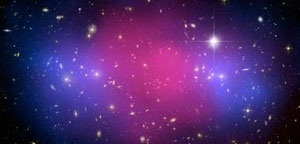New space images may support existence of “dark matter” in the universe
29 Dec 2008
In spite of quantum leaps in human knowledge about the mysteries of space, some answers still elude us. One of them is the very fundamental question of the most popular constituent of the universe. If visible matter, composed of the same neutrons, protons and electrons as Earth and its constituents are considered, they add up to only a small fraction of the calculated weight of the universe.
Hence, scientists are on the search for that elusive ''dark matter'' that may constitute the bulk of the universe.
 It is thought there is five times more dark matter than visible matter in the universe. Experts believe that, as the universe was being formed after the Big Bang, the gravitational force of this huge quantity of dark matter formed planets and galaxies, shaping the cosmos.
It is thought there is five times more dark matter than visible matter in the universe. Experts believe that, as the universe was being formed after the Big Bang, the gravitational force of this huge quantity of dark matter formed planets and galaxies, shaping the cosmos.
Now, research in this field got a shot in the arm when images of a spectacular intergalactic collision between galaxy clusters were revealed recently. The pink in the picture above indicates ordinary matter - mostly hot gas - while the blue area is believed to indicate the presence of dark matter. As the two clusters merged at millions of miles per hour, the hot gas collided and slowed down, while the dark matter did not, explaining the wider spread of blue.
The collision happened halfway across the universe, 5.7 billion light years away, about 100 million years ago. The image of the cluster, known as MACSJ0025.4-1222, was captured with the NASA Chandra X-ray Observatory and the Hubble Space Telescope. Each of the colliding clusters weighed one million billion times the weight of the sun.
Richard Massey, an astronomer at the Royal Observatory, in Edinburgh, who took part in the research, said life would not have come into being without dark matter, so any new clues were a step forward in investigating the make-up of the universe. He said the universe could not have formed "without the dark matter scaffolding being there in the first place".
"It is very important and crucial. Life wouldn't exist without this stuff," he said.
The discovery backs evidence from an earlier image of colliding galaxies, known as the Bullet Cluster, which also showed evidence of a separation of dark and ordinary matter, two years ago. The new results show the Bullet Cluster was not an exception and that the earlier results were not the product of an unknown error.
The latest study was carried out by an international team of astronomers, led by Marusa Bradac, of the University of California Santa Barbara, and Steve Allen, of the Kavli Institute for Particle Astrophysics and Cosmology at Stanford. Other collaborators included Tommaso Treu, Harald Ebeling, R Glenn Morris, Anja von Linden and Douglas Applegate. Their results will appear in the Astrophysical Journal.






























